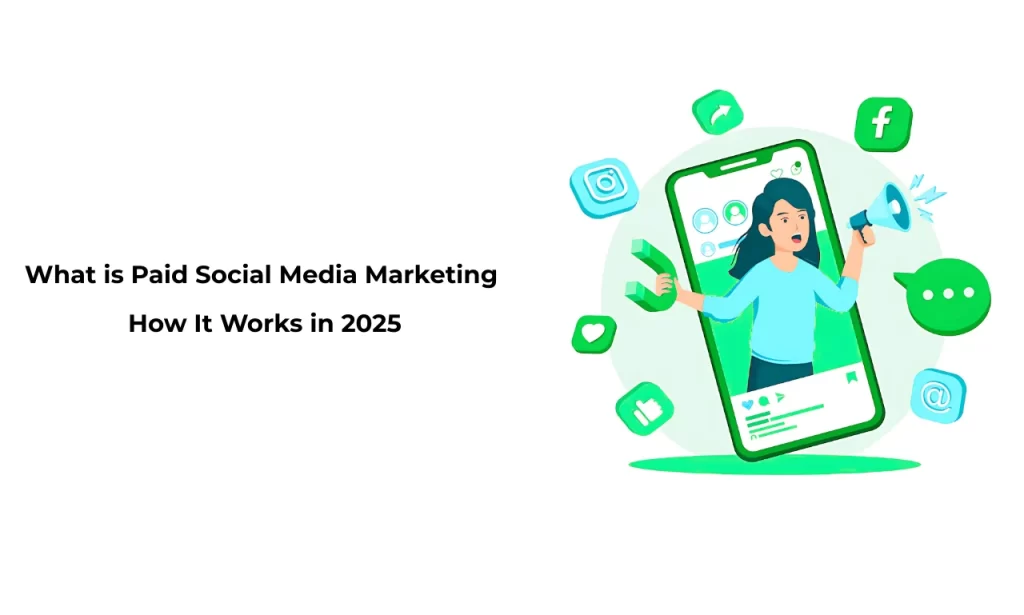Given the fact that the use of the internet has become almost inevitable, particularly in the current evolving world, Paid Social Media Marketing has been regarded as one of the best strategies through which companies can benefit by increasing their brand awareness and achieving their sales potential.
When it comes to advertising on social media by the year 2025, technological advancements have created more advanced ways of marketing. This will serve as a basic introduction to Paid Social Media Marketing, where it will dwell much on the importance and benefits of this method and the major trends that define it in Predictions 2025.
These strategies, when effectively applied in business environments, will assist in maximizing the return on Investment (ROI), making the business sustainable and competitive.
1. What is Paid Social Media Marketing?
Paid Social Media Marketing can be defined as the use of paid opportunities in social networks to accomplish particular marketing goals and objectives.
As opposed to organic social marketing, also known as social media marketing, which involves creating content that will go viral and engage the fans, paid social media marketing involves paying specific platforms like Facebook, Instagram, Twitter, LinkedIn, and TikTok to post advertisements to users.
Currently, this approach can help businesses get in front of users who might never have come across the business in their regular interactions.
Why Businesses Should Leverage Paid Social Strategies?
In the current world of commerce, composed of constant technological advancements, you have to be very adaptive and creative in your marketing strategies.
Even though paid social media marketing is comparatively expensive, it has reasonable benefits of precise targeting, live analytics, and creativity to achieve the targeted goal by connecting with people.
Through paid social approaches, businesses stand to benefit from increased sales, leads, and brand recognition at an affordable cost.
Looking forward to 2025, the expectation as well as the potential to reap high ROI through paid social is on the rise. Therefore, it can be regarded as an imperative quadrant of the marketing mix.
How Paid Social Differs from Traditional Advertising?
There are various reasons that differentiate paid social media marketing from conventional advertising: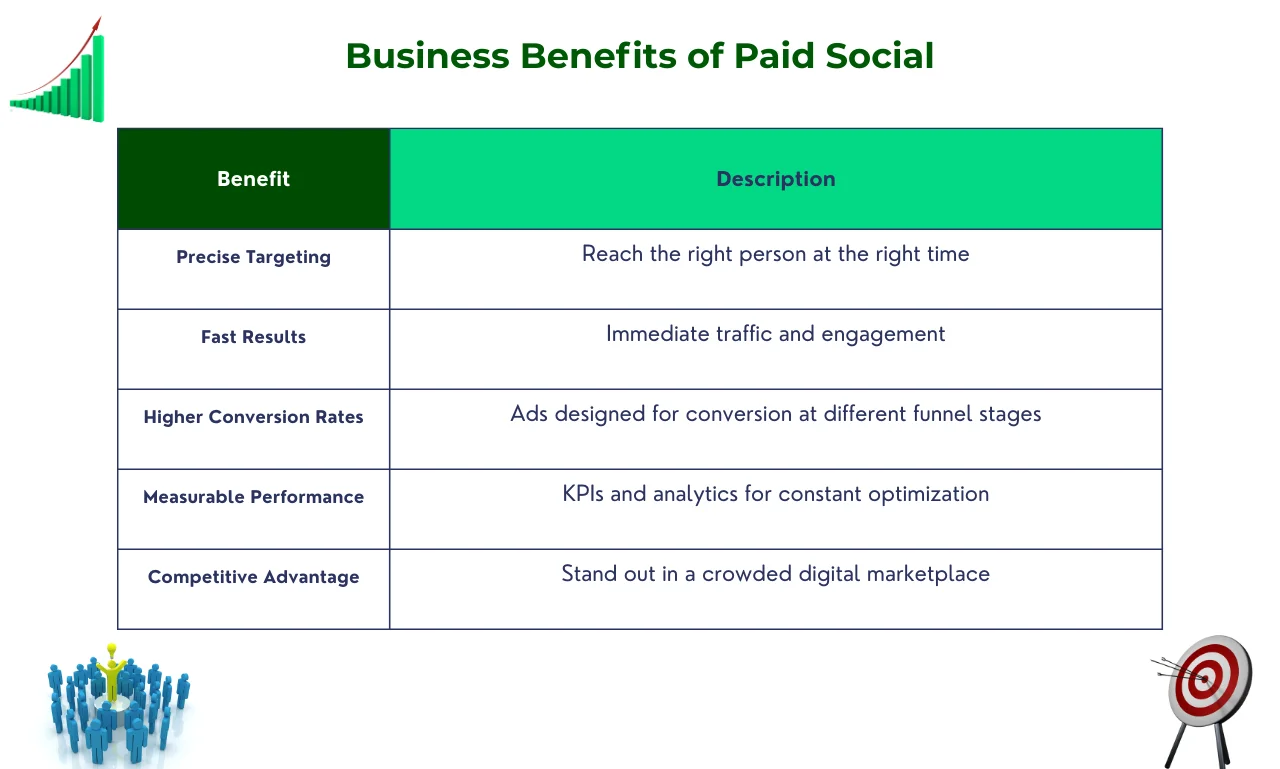
- Targeting Precision: With Facebook and other social media, there are targeting capabilities that allow targeting based on demographics, interests, behavior, and life events.
- Interactivity: Facebook and Twitter ads specifically allow users to interact with the ad by having them ‘like’ the ad, comment on it, or follow the link that directs them to the website’s landing page.
This interaction fosters a deeper connection between the brand and the audience.
- Real-Time Analysis: The option to monitor the efficacy of social media for advertising in real time enables advertisers to fine-tune their campaigns to achieve better outcomes.
- Cost Efficiency: Through PPC, an organization only has to pay for impressions that clients give to advertisements, which makes it cheaper than standard mass media-placed adverts.
- Ease of advertisement Flexibility: Paid social allows for flexibility in advertisement and comes in the forms of images, videos, carousels, and stories, among others.
Key Trends Shaping Paid Social in 2025:
When it comes to seo, digital marketing, website paid ad social media marketing, here are a few aspects that are potentially the future trends for the year 2025.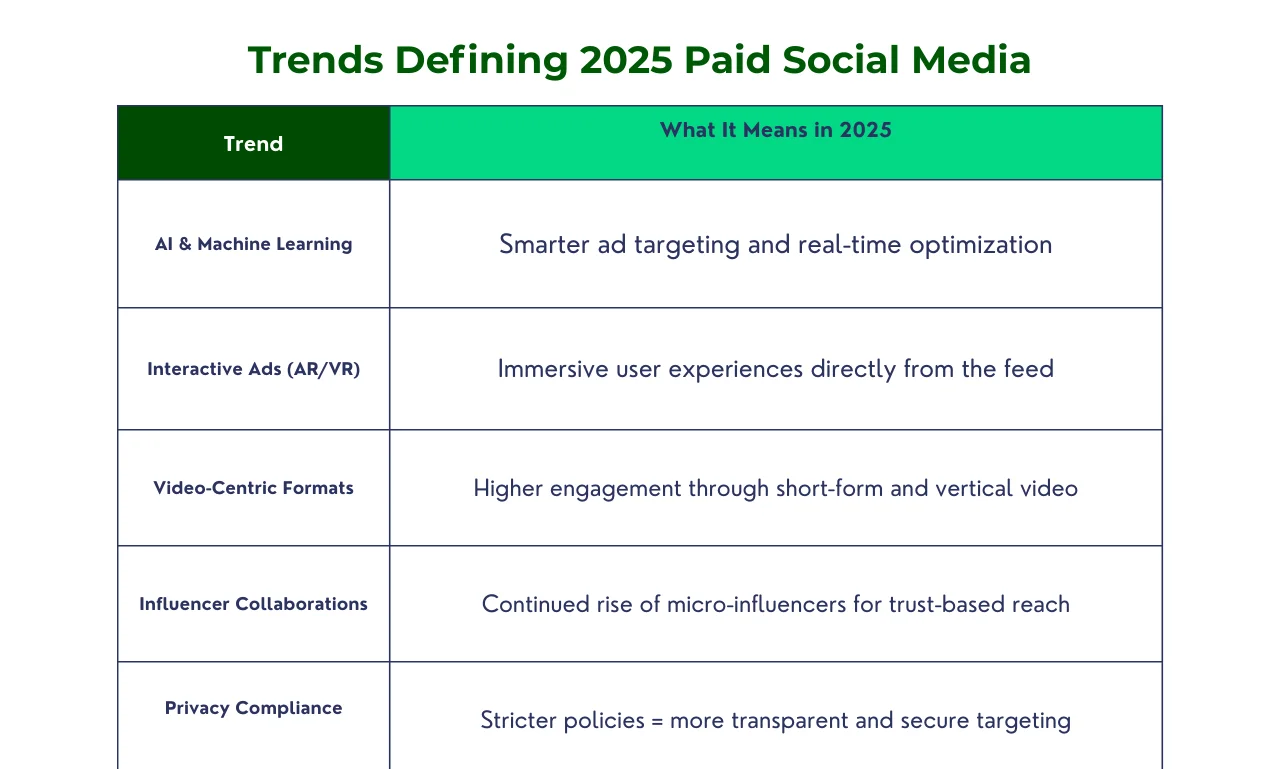
- Artificial Intelligence and Machine Learning: These two factors will improve ad targeting, ad personalization, as well as ad optimization for improved campaign outcomes.
- Interactive Advertising: The new forms of ads will be closely connected to AR and VR, allowing them to immerse themselves in the ad’s content.
- Video ad Content Level: There will be an increasing tendency of video ads, where platforms will come up with different ways of presenting videos, such as short videos and other interactivity, such as videos within videos.
- Influencer Collaborations: A crucial trend wherein regular collaborations will continue to come into the foreground, especially micro-influencers.
- Privacy & Data Security: There has been a growing concern about the use of the internet. As a result, there will be an increase in online privacy policies that affect how businesses will engage users on the platforms.
2. Types of Paid Social Media Ads & Real-world Examples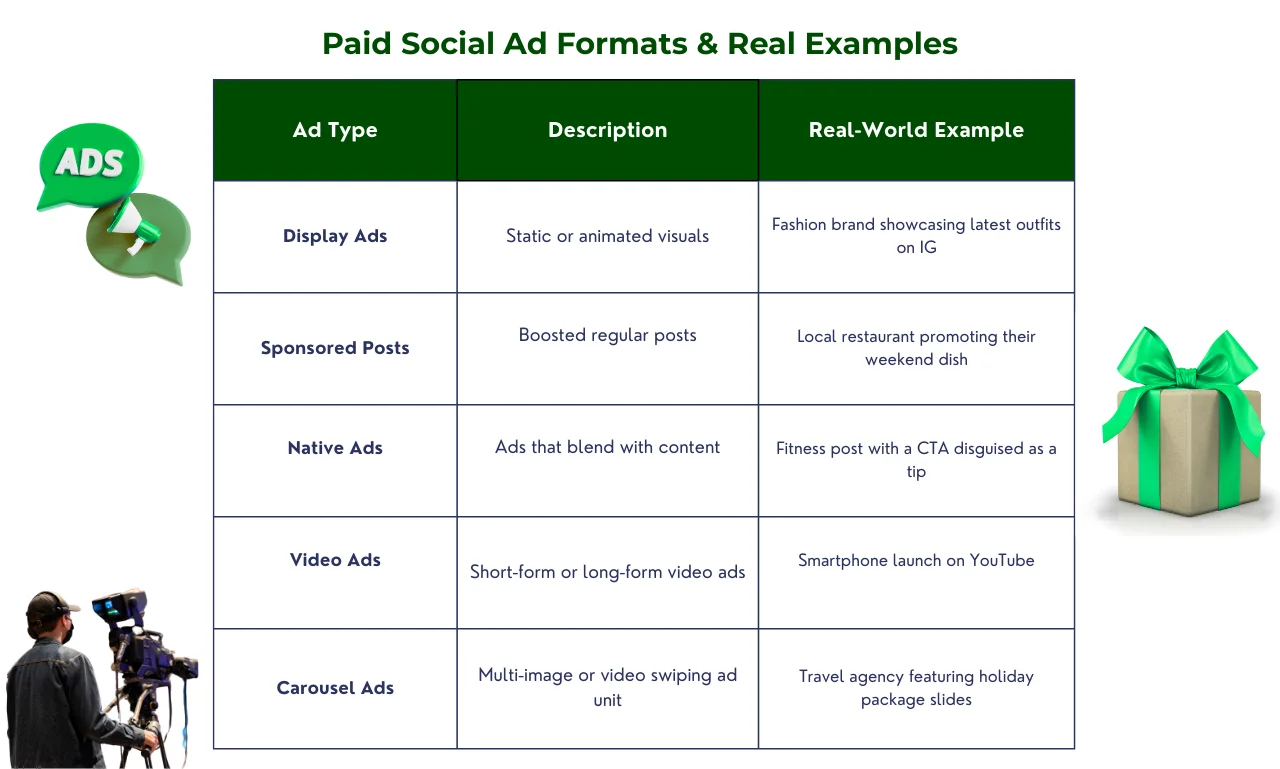
1. Display Ads:
Display ads are in the form of images and videos that can be posted on the news feed or sidebar of social networking sites. It is also possible to post images, GIFs, or even a video if an advertiser wants.
Example: A fashion firm may employ Instagram display advertising to advertise apparel by posting beautiful pictures of the new fashions.
2. Sponsored Posts:
Sponsored Posts are ordinary posts that have been enhanced with some funds through promotion. The messages are displayed in the feed sections of the selected users.
Example: A local restaurant may use a post about their specialty dish and ensure to target the food lovers in the region.
3. Native Ads:
They are disguised as ads and are integrated into the platform, coming in the form of a regular feed post or a story. Also, they are intended to mimic organic posts visually to avoid being easily flagged by the algorithms.
Example: A fitness brand may design a native advertisement to look like an inspirational message on the Facebook platform to promote a fitness challenge.
4. Video Ads
Video ads are forms of advertisement that can be video mobile advertisements in the story and video mobile advertisements in the news feed. Alternatively, they are very interactive and can get the attention of the target audience within a short period.
Example in Commerce: A mobile phone maker such as Nokia can use video commercials aired on YouTube to illustrate the features of a new model of a mobile phone.
5. Carousel Ads
Carousel ads work in a way that the advertisers get to use a single ad space to post multiple images or videos. To reveal more scrolls, the user can swipe to the right from the current item of the carousel.
Example: A slide show could be used on Facebook’s carousel ads, where every single slide describes clients and holiday packages, and each slide comes with a beautiful background.
6. Influencer Collaborations
Influencer marketing refers to the process of using other people with large followings on various social media platforms in the promotion of products or services.
Example: A company in the beauty niche could associate with an Instagram beauty influencer to post natural material for a new skincare line.
3. Organic vs. Paid Social Media: Key Differences
Before taking a close look at paid social media marketing, it is imperative that you first have knowledge of its counterpart, which is organic social media marketing.
It aims at utilizing complementary accounts and posts, communicating with people inside a society, and sharing articles.
However, it is generally slower and not as constant in comparison to the results that can be obtained through other methods of development.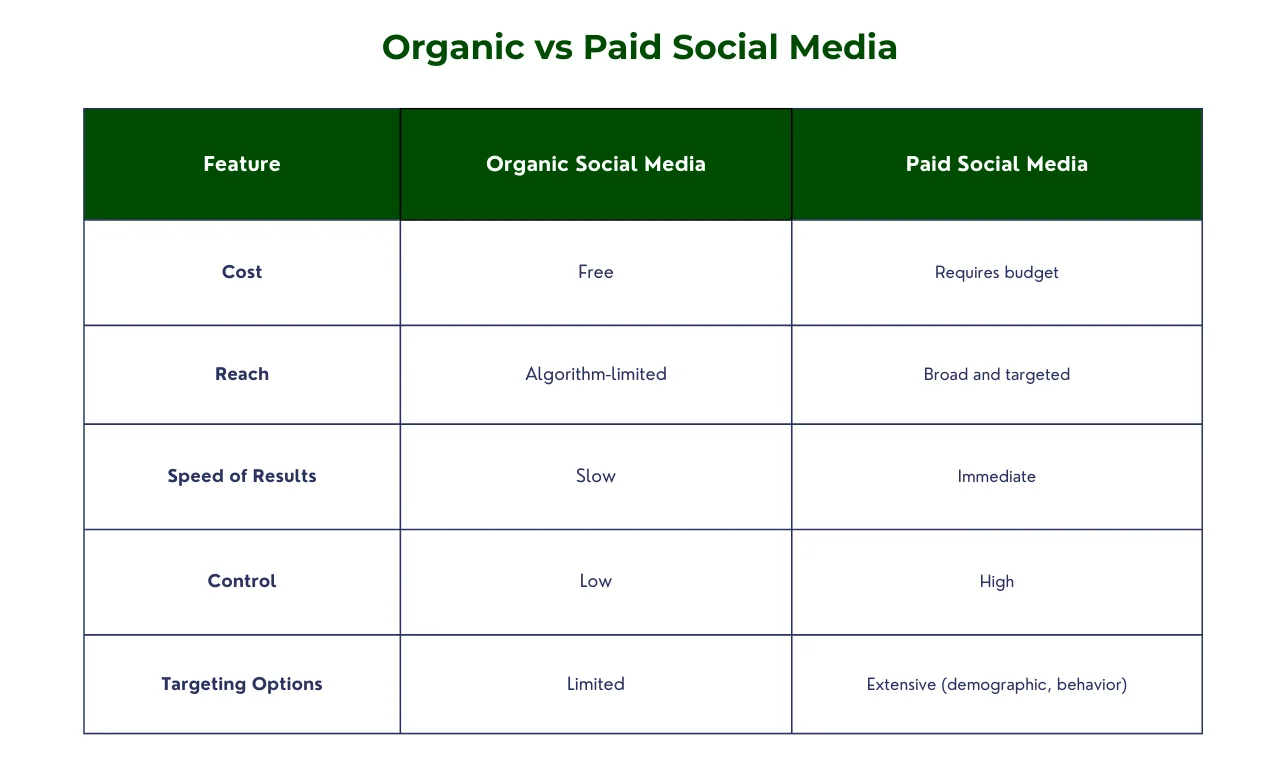
Reach and Engagement:
Organic reach is substituted by algorithms. In this case, posts may not have the chance to appear to the target audience, only a few may see them, despite having great content that people will engage with or share.
On the other end, paid social media provides your content with certainty, which makes it visible to a certain demographic group.
Audience Targeting:
Organic posts will not only reach the followers but also the users who tend to be interested in such content, whereas paid campaigns allow choosing more options.
It is also possible for marketers to reach their audience with the help of different targeting options available in 2025, such as demographic targeting, interest targeting, behavioral targeting, and lookalike targeting.
Balancing Strategies:
Organic and paid strategies complement one another by covering a vast population and paying primary attention to the most efficient target.
Organic is the way to let people know who you are and to create a community. On the other hand, paid actions are specific and result-oriented.
4. Why Invest in Paid Social Advertising? (Key Benefits)
With the competition forecasted to rise in the year 2025, employing paid social adverts as a marketing tool is beneficial to any business growth.
Enhanced Targeting and Audience Segmentation:
Social media advertising is the process of paying a social network to promote a business’s content for better visibility to the right audience.
The audiences can also be split by using parameters such as demography, psychology, online activity, and geographic location.
Faster Growth and Measurable Results:
While deciding on an organic approach has its benefits, paid campaigns on social networks are way faster.
Through this, it is easy for the productivity of a certain campaign to be assessed at the earliest time possible, and necessary changes can be made in the quickest time possible.
Higher Conversion Rates:
This is a form of advertising placed on independent social networks, aiming to change the identified users into customers. Organic efforts cannot reach that kind of efficiency since it is possible to address specific target users at the proper stages of the buyer’s journey.
Competitive Advantage:
It is critical to know how to position oneself in the year 2025 or beyond 2025 in the field. It is important to hire a social media strategy for paid advertising because it helps a brand stand out as the world goes digital.
5. Top 5 Platforms for Paid Social Campaigns in 2025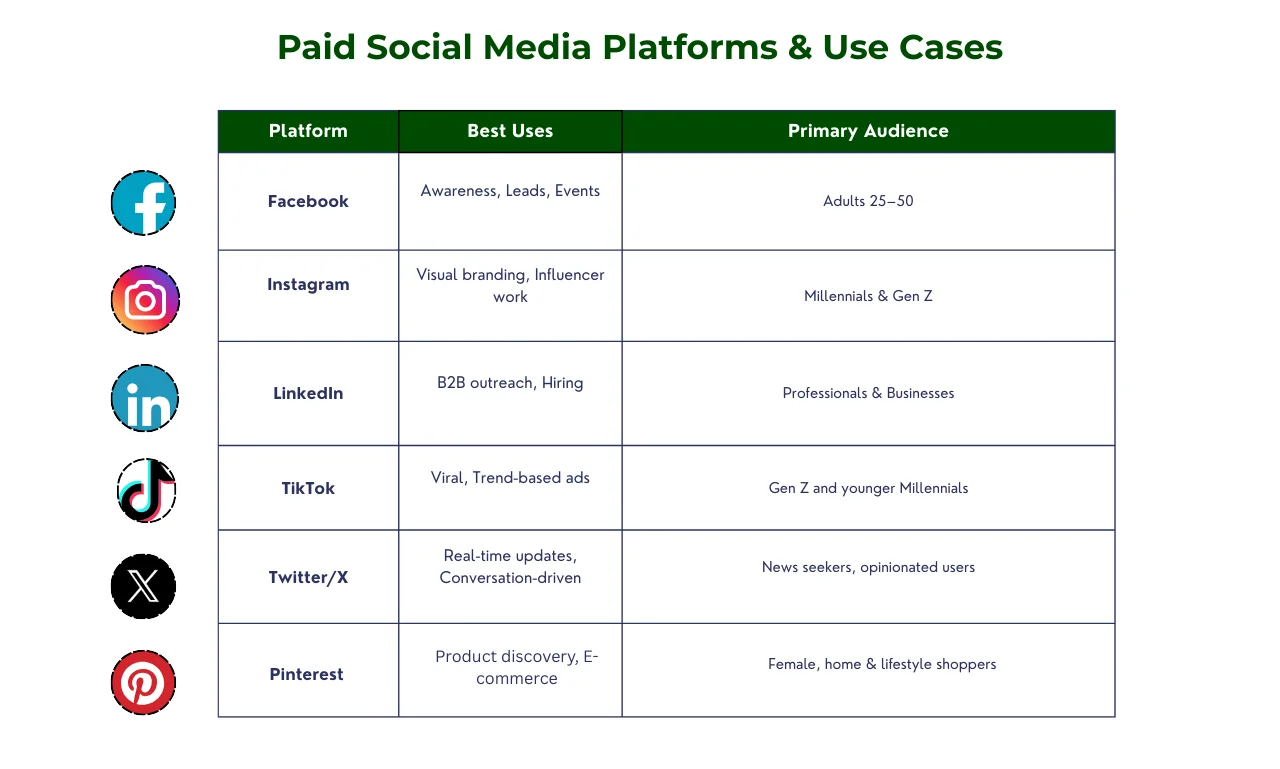
1. Facebook:
Best Uses for:
- Brand awareness
- Lead generation
- Event promotion
Target Audience:
This feature makes it possible for so many people to be on the Facebook page, which makes it easy to get a large number of the selected demographic.
It is especially useful to address users with the help of descriptive demographic and interest filters.
2. Instagram:
Best Uses for:
- Visual storytelling
- Influencer collaborations
- Product launches
Target Audience:
Instagram is ideal for targeting millennials and Gen Z’s which is why it has a higher proportion of young users.
Its visual orientation is especially suitable for brands that have rich and visually appealing content.
3. LinkedIn
Best Uses for:
- B2B marketing
- Talent acquisition
- Professional content sharing
Target Audience:
LinkedIn, due to its professional setting, is good news for B2B businesses that seek to target clients and key opinion makers.
4. TikTok
Best Uses for:
- Viral marketing
- Trend engagement
- Creative storytelling
Target Audience:
TikTok is popular among young people today. Therefore, you can use it as a means of targeting Generation Z with unique and informative content.
5. Twitter/X
Best Uses for:
- Realtime engagement
- News and updates
- Conversational marketing
Target Audience:
Twitter is best utilized to reach those audience members who are interested in hot topics and updates regarding new events in the industry.
That is why it’s suitable for brands that are good at casual and time-sensitive content.
6. Pinterest:
Best Uses for:
- Ecommerce promotions
- Inspiring visuals
- Lifestyle branding
Target Audience:
Pinterest is especially suitable for households and women because it is based on pictures and images.
It is most suitable for fashion, home furnishing, food and beverages, and lifestyle products and services brands.
6. 9-Step Framework to Build a Winning Paid Social Strategy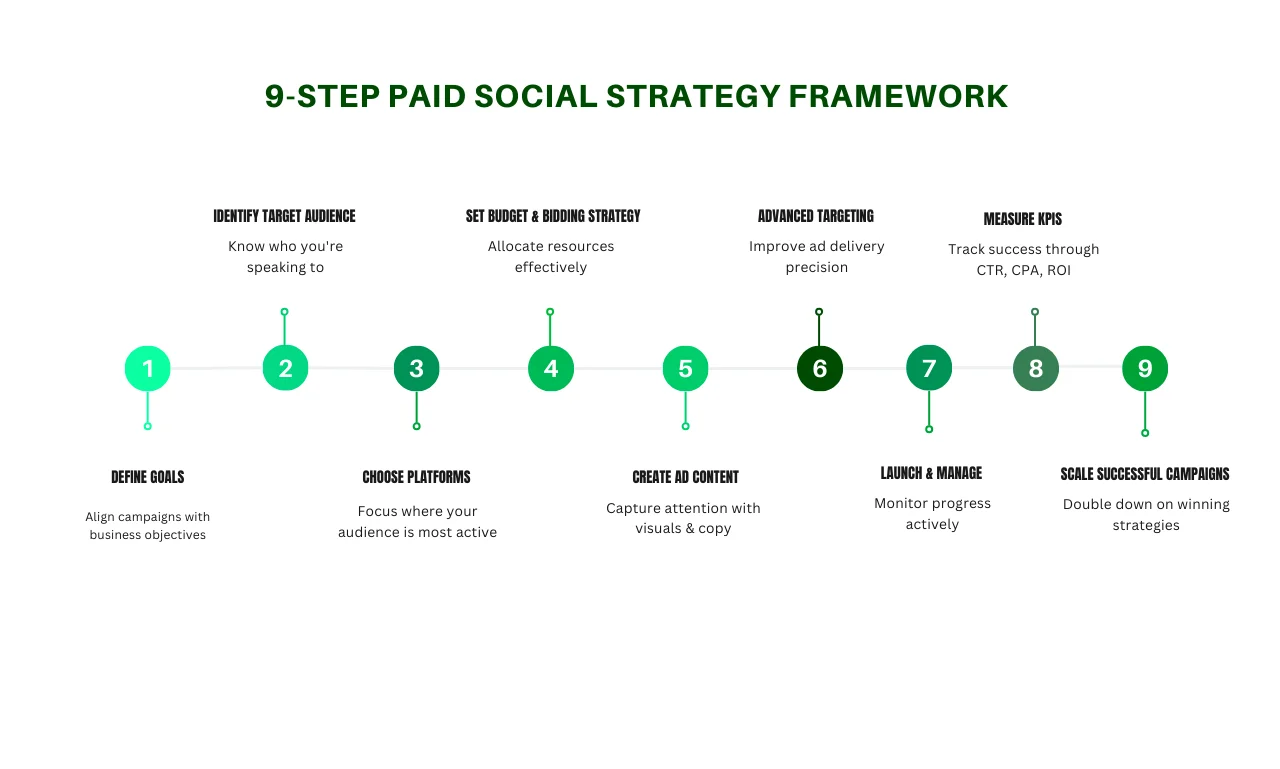
1) Define Clear Campaign Objectives:
It will be wise to have specific goals before any paid promotion on social media platforms. Here are some goals you can consider:
What do you want to achieve?
What is generally the goal of your social media promotion, website traffic, website sales, or leads?
Developing specific goals will assist you in determining the level of success within a predetermined process or project. Moreover, it will also ensure that the process you are going through is in line with the goals of the business.
2) Identify and Research Your Target Audience:
You need to know with whom you are dealing, meaning your target audience.
Always study your target audience to understand their age, gender, and other aspects, likes and dislikes, and their general attitude towards your product or service.
Some of the tools that can be used include social media analytics, customer feedback, and competitor research.
If you know about your audience insight, it will be easier for you to take steps to enhance the effectiveness of your current campaigns.
3) Select the Right Social Platforms:
It is imperative to note that not all social platforms may areal to use in your campaign. This means that you should choose the platforms that you are aware your target clients use most.
For instance, if you are targeting business people, it is advisable to use LinkedIn. However, if your audience is younger, it is wiser to target the stocks on Instagram or, even better, TikTok.
4) Set a Realistic Budget and Bidding Strategy:
Budgeting is an interesting decision where you need to compromise.
You need to aim high enough so that you can have enough to achieve all that you want, but not so high that to end up spending more than you bargained for.
The setting of your daily campaign is based on the goal or objective set and the available social media platforms to use.
Also, specify the bid type that is most suitable for your campaign, as it may be CPC, CPM, or CPA, depending on what one aims at achieving.
5) Craft Compelling Ad Creatives and Copy:
Ad creatives and copy messages represent the core of your advertising campaign.
They should be shared in a visually appealing way and should grab the attention of the audience to whom they are addressed.
You can also use high-quality images or videos, great headlines, and compelling content to make customers stop in their tracks.
Note that your ads should convey your message of how you can fulfill their needs and convince your audience to take a call to action.
6) Implement Advanced Audience Targeting:
Maximize your audience to target your desired group of the population to give a product at the appropriate time.
Demographics, interests, behaviors, and custom audiences are among the criteria that make it easier to target the audience.
There are specific targeting possibilities of delivery at platforms such as Facebook and Instagram through which you can reach the right people.
7) Deploying, Tracking, and Managing the Campaigns:
After implementation, your campaign is live, and now it is high time to keenly observe how it is performing.
The collected data should be analyzed with the help of analytical instruments to identify such values as impressions, clicks, as well as conversion rates, and Return on Investment.
Perform metrics calculations to know the strengths and weaknesses of your current campaign.
Incorporate necessary changes about creatives or targets, or even budget, to enhance the performance of the related campaign.
8) Track KPIs and Measure Performance:
The next step is to monitor the KPIs to measure the achievements of your campaign.
Decide which of the KPIs are relevant to your goals, including CTR, conversion rate, CPA, or ROI.
You can track these KPIs to evaluate the effectiveness of current campaigns and make informed decisions about future activities.
9) Scale Successful Campaigns for Long-term Growth:
So, after this, the next step is always how to scale those campaigns for durable and sustainable growth.
Choose the audiences that you want to reach, increase your budget, or use the successful strategies that you have used in other campaigns.
Scaling is what enables you to get the most out of your success and achieve continuous commercial success for your business.
7. Expert Tips to Run High-Converting Paid Social Campaigns
1) A/B Test Ad Creatives and Messaging:
Split testing or A/B testing is one such tool that can help identify what is effective or not among the audience.
It is recommended to produce different variations of your ad creatives and the related advertisement message, and then compare the results.
It makes it easier for you to optimize your ads to be as effective as they should be in converting people.
2) Leverage AI and Automation Tools for Optimization:
Paid social can benefit greatly from the use of AI and automation tools.
Some of the tasks that can be addressed by these technologies include bid management, targeting, and scheduling, among others.
So, using AI and automation, you can consider such changes with optimal alertness, and without the need for frequent intervention and manual touchups.
3) Retarget Engaged Users for Better Conversions:
Remarketing is one of the most effective techniques that help in the transition from a user to a customer.
You can sell to them directly by using retargeting advertisements when the visitor is leaving your website or did not respond to the ads you posted.
It is important to leverage the retargeted ads by adding comments on the potential objections that might be there to the customers and using a call to action, which may include a discount rate or time-sensitive offers.
4) Stay Updated with Platform Algorithm Changes:
The prominent social media platforms are dynamic in the sense that they always modify their algorithms, which can affect your campaign.
This can be accomplished through constant updates with the stream of industry news, forums that are associated with the platform, or managing subscriptions to application updates.
Additionally, you should limit your risk level and stick with the methods that are relevant to present algorithmic trends at the same time.
Ending Thoughts:
For paid social marketing to be effective, there should be development, implementation, and optimization of the efforts. That is why by following our 9-step framework and applying other tips and tricks, you will achieve a successful emergence of high-converting campaigns for your business.
Just recall that despite all the debates about marketing being an art, it is an effective program that depends on accurate audience study, appealing messages, and constant testing and analysis.
At Three Angle Marketing, we assist you through our paid social media marketing services to meet your goals. Don’t wait, and get in touch with us to embark on a digital marketing campaign for your business.

